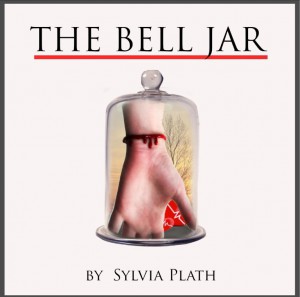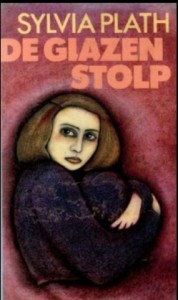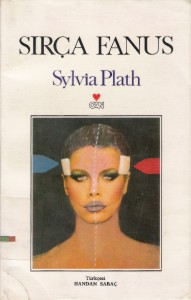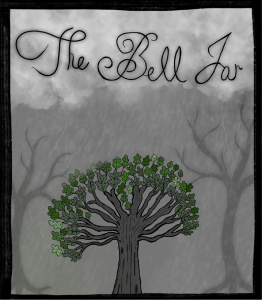PART 1 Naiomi Ramos part 2 Naiomi Ramos2
Category Archives: Project #2
Project #2 part 1 and 2
Kevin Mendoza
Professor Rosen
Women Writers
May 2014
Project #2 part 1
The Bell Jar by Sylvia Plath has had its cover page, illustrated in various forms over time. These various illustrations of the Bell Jar have depicted different messages or ideas expressed through the novel. There are versions that are similar due to their expression of the character, Esther Greenwood, and different by which one shows the struggle of having to choose between marriage or a career and the other exemplifying innocence and purity. Esther goes through various dilemmas where she even has shock therapy, is almost raped, loses her virginity. There is the notion that Esther is constantly being trapped by her own mind and indecisiveness. The covers that best fit this analogy is the first Heinemann edition published January 14, 1963 under the pseudonym, Victoria Lucas and the other version was published by Harper Perennial modern classics (2005).
In the first original version cover, the book has a very metaphorical approach that goes with the idea of Esther having a hard time deciding whether to become a woman that tends housewife duties or pursuing her career in writing. The cover has that 1960’s vintage look to it that allows me to have a nostalgic feel for the image. The cover has a light grayish background that allows the shadow woman to standout. The shadowed woman has no visible face, but you can make an inference that the shadowed woman is Esther, and is in ponderous posture where she having her conflicting thoughts. The woman has her hand clenched that gives the notion of her thinking. “So I began to think maybe it was true that when you were married and had children it was like being brainwashed, and afterward you went about as numb as a slave in a totalitarian state.” this quote exemplifies the constant battle between choosing to be the wife that fulfills every household role. Then there is a giant glass bell jar that the woman is in while sitting in the chair. The Bell jar has its representation of the Esther being trapped within her own mind so it is impossible for her to make a decision in following the norm implemented by her mother, Buddy’s mom who is suggestive of her to settle with Buddy or choosing a career path , which this conflict is challenging her sanity. A quote that fits the description of the woman in the giant bell jar is stated, “The bell jar hung, suspended, a few feet above my head.” I think that this quote is very helpful in proving that the woman in the giant bell jar is Esther as well as “Wherever I sat-on the deck of a ship or at a street café in Paris or Bangkok-I would be sitting under the same glass bell jar, stewing in my own sour air”. The Bell jar represents Esther’s clouded mind and the hand gesture of the hand holding the woman’s face, shows frustration. “To the person in the bell jar, blank and stopped as a dead baby, the world itself is the bad dream”; the shadowed woman in the bell jar has is trapped, like if she were in a bad dream. Esther, from the Bell Jar, is trapped why the madness instilled upon her by her mental problems. All her troubles are heightened to a pinnacle point, when she is trying countless times to commit suicide. This cover illustration strongly brings out theses analogies of Esther’s overall position in the novel for readers to view. Towards the end of the text, Esther has finally overcome the burden of being indecisive, and states, “How did I know that someday-college, in Europe, somewhere, anywhere-the bell jar, with its stifling distortion, wouldn’t descend again?” This quote is very significant to the idea of the illustration of the cover, because Esther understands that the bell jar, symbolism for madness and being trapped, might come back one day to haunt her.
The cover version of the Harper Perennial modern classics 2005 version has very controversial image of only half a woman’s body being shown. The image only shows the woman from below the waist further down. The background of the cover is a blue and grayish color, while the dress the woman has on, has a much darker color to it that allows the it to stand out from the rest of the cover. In this image, the title is on the lower right hand corner so the image of the woman is the center of attention. This version seems to explore the themes of purity and innocence. Esther throughout the novel is not sure about purity and marriage and how she should go about it. She has encounters with this idea express by Sylvia Plath when she is almost raped by the Spanish man, when she finds out that her college boyfriend is not a virgin like her, and the time when she finally loses her virginity to the man. The image allows one mind to wonder further by the long dress and showing of her legs from the knee down. One conclusion that the cover can give is the fact that is it takes place in the 1950’s, and woman are suppose to be pure when they get married. Women at this time had to be very reserved and exploiting her sexuality was a taboo. Perhaps it is because of the theme of purity is shown in the cover. The author Sylvia Plath states the way woman are suppose to portray themselves when she stated in the article, “The main point of the article [“In Defense of Chastity”] was that a man’s world is different from a woman’s world and a man’s emotions are different from a woman’s emotions and only marriage can bring the two worlds and the two different sets of emotions together properly […] This woman lawyer said the best men wanted to be pure for their wives, and even if they weren’t pure, they wanted to be the ones to teach their wives about sex.” The cover of the woman is well represented by this quote, because it relates to the fact that a woman is suppose to a virgin, also known as being pure, before getting married to a man. Even wouldn’t matter if the man is not, a virgin Esther, the main character, gets upset when she finds out that her boyfriend, buddy, is not a virgin. The reserved woman in the cover is also how Esther overcomes her losing virginity so she breaks out of the norm of having to be constricted by marriage. The cover of the woman with the long dress shows innocence and how it was almost taking savagely in bell jar, by Marco, when he tries to rape Esther. A quote that depicts this scene and explains it stated, “I began to see why woman-haters could make such fools of women. Woman-haters were like gods: invulnerable and chock-full of power” The cover exemplifies both the theme of purity and innocence, and how Esther deals with how to live her life and break out of the norm of having to assimilate to society.
Both covers have dabbled into different themes of the text, “The Bell Jar.” The cover that best fit for the story itself is the first original cover from the 1963 publication. When you read the title, “The bell Jar”, you want the cover or the illustration to give an idea as to what the text, might be about. The giant bell jar, gives with the shadowed woman give insight to the reader and the metaphorical message of being trapped. With the cover of the woman’s half body, with the long dress and legs showing below the knee does not flow with the title. This cover plays out more of a complex idea, where deciphering what the meaning of the woman’s half body only being shown and legs have correlation with the title, “The Bell Jar”.
Ultimately the illustrators of both covers had different ideas that they developed these unique covers. One has shows the obvious meaning of bell jar and how important of a symbol it will play out. The other uses a different method that might throw you off with a woman’s half body with a long dress. Esther is experiencing all these ideas that the covers envelop, like feeling trapped, indecisiveness, dealing with the understanding of her purity and innocence.
The Bell Jar
Part
2
An image that I believe that would best fit a cover for Sylvia Plath’s book, the “The Bell Jar”. This image is a woman crouched inside a giant jar. The giant jar is on a dark gray surface and the background shows is a light gray. The color, gray sets a depressive move. The woman inside the actual jar is wearing black and is so crunched over that her knee. The jar is not spacious and has a lid on it. The woman is trapped and looks depressed on how her back is hunched over as well, like if she is helpless in getting out. It is not a Bell jar, what metaphorically, it shows how Esther from” The Bell Jar” , was trapped in an imaginary bell jar that was really her mind and the troubles of marriage or seeking a independence by having a career.
This cover fits the story, The Bell Jar, because this image shows the theme of Esther’s mind being a trap. She becomes mentally unstable that sends to a psychiatric center. She struggles by trying to find herself in society she has to make the choice of either being successful in a career or being married and be taking care of a family. A quote that is
“I saw my life branching out before me like the green fig tree in the story. From the tip of every branch, like a fat purple fig, a wonderful future beckoned and winked. One fig was a husband and a happy home and children, and another fig was a famous poet and another fig was a brilliant professor, and another fig was Ee Gee, the amazing editor, and another fig was Europe and Africa and South America, and another fig was Constantin and Socrates and Attila and a pack of other lovers with queer names and offbeat professions, and another fig was an Olympic lady crew champion, and beyond and above these figs were many more figs I couldn’t quite make out. I saw myself sitting in the crotch of this fig tree, starving to death, just because I couldn’t make up my mind which of the figs I would choose. I wanted each and every one of them, but choosing one meant losing all the rest, and, as I sat there, unable to decide, the figs began to wrinkle and go black, and, one by one, they plopped to the ground at my feet.”
This quote represents how Esther is unclear what choice she is supposes to make because she wants independence or be happily married. So this is why an image like this, would fit with the story and the idea of conflicting choices.
Cover 1: Harper perennial classic edition, 1999 publication
Cover 2: Faber and Faber, 2013 publication
Andreu Gonzalez
5/01/14
Sylvia Plath’s the bell jar is somewhat of a dark novel depicting the journey of a young woman’s journey into depression. The novel has many dark themes like suicide and questionable sexual conduct and themes. Though one should never judge a book by its cover, the purpose of the cover is in fact to attract new readers as such it is very important that the cover addresses major events with in the novel, an overarching theme, or major motifs in the plot.
The Harper perennial classic edition, 1999 publication of the bell jar depicts a young girl in a white dress standing in front what looks to be either small trees or shrubs with the most visible objects being the white dress and the branches of the shrubs. The cover seems to be depicting one of the major turning points in Esther’s life; the country club ball esthete is set up on a blind date with a Peruvian man named Marco. “It doesn’t take two to dance, it only takes one.” Here Esther is asked by her date to dance but Esther is immediately reluctant, Marco than imposes himself on her by throwing away her drink and forces her to partake in the party grabbing her hand hard enough to leave marks. After the dance she is taken outside by her captor Marco proceeds to then to shove her down and fore himself upon her. One can interpret the cover taking place before or after these traumatizing events as her outfit does match the occasion.
The clothes depicted in the cover may be the very outfit lent to her by her friend Betsy. The cover is foggy or aged as if to give a feeling of uncertainty or degradation like that of an old mistreated picture. After the party Esther returns to her stay and begins to empty out her wardrobe leaving only the one piece of clothing she had on
The fact we can’t see the cover girls face also plays to Esther’s Esther emotional instability.
The Faber and Faber, 2013 publication sparked controversy for its questionable decisions in illustration the cover depicts a woman using a pocket mirror to apply makeup with a vibrant red background. At first glance the cover fails to convey the tone or mood of the book to the point of appearing deceitful to those who have never read it the cover does not match the tone of the book. One could argue that the cover does not convey Esther’s emotions properly, Esther is a girl suffering from social anxieties and deep depression yet the cover depicts a more confident woman who does not appear to be in the least bit troubled and seas as if she might actually enjoy the party. The image depicted in the cover suggest that whoever composed it only read the early chapters ignoring a lot of the major points in the novel. Being that the novel is about a woman continuously being drowned by the social expectations of her gender to the point of being driven to depression, yet the novel is publicized with image of a young lady applying makeup with a pretty light red background.
However the 50Th anniversary does depict a pivotal scenes in Esther’s life. “ I still have the makeup kit they gave me, …., an oblong of brown mascara with a tiny brush, a round basin of blue eye-shadow just big enough to dab the tip of your finger in, and three lipsticks ranging from red to pink, all cased in the same little gilt box with a mirror on one side.” In this scene Esther comments on the makeup kit given to her by her long ago. Though arguably not as dark as the first cover the 50th anniversary can be consider somewhat ironic depicting a normal looking or even confident woman is faced for a depressed and unstable young lady. It could also depict Esther’s struggle with identity, throughout the novel she can’t seem to decide who she is. The cover may be depicting the moments where Esther’s is having problems with identity. Identity is a major theme used in the novel as there are many times in which Esther can’t recognize herself when looking at her own reflection “If I looked in the mirror while I did it, it would be like watching somebody else,”(Pg.147).
As opposed to the second cover, The Harper perennial classic edition, 1999 publication of the bell jar feels darker, the haze that surrounds the image gives a feeling of uncertainty to the world foreshadowing the grim and tragic fate of Esther. The covers natural surroundings could be a nod to the scene where the Esther learns of a couple that met under a fig tree. She later relates the story to herself as it was similar to her relationship with Buddy, The fig tree represents the different choices she could make “I saw my life branching out before me like the green fig tree in the story. From the tip of every branch, like a fat purple fig, a wonderful future beckoned… choosing one meant losing all the rest” (page 62) In these scene Esther describes her thirst for exploring every possibility available to her but then unable to choose because picking one would close the others, This was a major moment in the development of Esther’s character the cover mirrors this by having a the trees behind her take such a large amount of the portrait and having Esther stand bellow her.
Though different, booth covers play to the different strengths of the novel depicting defining moments or themes that characterized Esther’s struggles using its dark themes and symbolisms to create an image that can represent the novel in a great way. Sylvia Plath’s the bell jar is a dark novel depicting the journey of a young woman’s journey into depression. The novel has many dark themes like suicide and questionable sexual conduct and themes. Though one should never judge a book by its cover, the purpose of the cover is in fact to attract new readers.it is the responsibility of the cover to give a face value representation of the subject at hand, as such it is very important that the cover addresses major events with in the novel, major themes, or repeated motifs in the plot. The Harper perennial classic edition, 1999 publication of the bell jar depicts a young girl in a white dress standing in front what looks to be small trees and shrubs with the most visible objects being the white dress. This cover is the more obvious of the two representing all the anxiety and uncertainty that Esther was trying to endure. The Faber and Faber, 2013 publication represents the Esther’s struggle with identity and the faced that she has often put in front of others. Being that identity is such a major theme in the novel there are many times in which Esther can’t recognize herself when looking at her own reflection. Booth covers choose to represent different major events with in Esther’s life but are able to hint at the major events and themes of the novel effectively.
The bell jar project two, part 2
PART TWO
The novel “The bell Jar” has been portrayed differently all around the world. For my cover I have chosen to represent the most symbolic symbols noted in the novel. These symbols include mirrors,fig tree, blood,and heartbeats. I choose my cover to represent these symbols because I believe these symbols depicts important moments in the novel. In the novel Esther worst enemy is herself,she knows that she wanted to kill herself but doesn’t have a logical reason as to why. As shown in the novel, Esther constantly confronts reflection on herself. After her shock treatment with Dr. Gordon she thinks her reflection is another women in the room and even more so after her last attempt to kill herself she couldn’t recognize herself in the mirror.
This moment is demonstrated in my cover in the reflection of the fig tree. The fig tree is also another important symbol in the novel. The fig tree is mentioned multiple times in the book. In Esther’s case, the fig tree represents a different life and she can only choose one. She struggles with the decision to make a choice. Esther’s inability to make a decision leads us to another symbol that is constantly used in the novel, which is blood. The shedding of blood marks transitions in Esther’s life. This includes when Marco tries to rape her and he smeared blood on her, when she loose her virginity she bleeds heavily, and when she decides to kill herself, she slashes her calf for preparation to slash her wrists. Esther slashing her wrist is shown vividly in my cover because this was the moment she first attempted to kill herself. The presence of blood shows that Esther will sacrifice her body for peace of mind.
Although she wanted to kill herself, she was unsuccessful in all attempts. Her failure to successfully kill herself is shown through another symbol of the novel, heartbeat. Her body was determined to live in all attempts. The beating heart symbolizes this bodily desire to live. In her attempt to drown herself, her heart beats ” I am I am I am.” The heartbeat is represented in my cover through the red heart by the hand. The mirror, fig tree, blood, and the heartbeat are very important aspects of the novel. I’ve tried my best to portray this idea in my cover by using four simple photos and combining them together to make one thing.
The bell jar covers
Spanish Edition. Dutch edition
Date:2005 Date: unknown
Esther greenwood is like most teenagers coming of age, young and ready to take over the world. In Esther’s case, she struggles greatly to be the normal women that society as portrait in the 1950’s. The Novel “The Bell Jar” by Sylvia Plath depicts the life of Esther Greenwood as she descent into and return from madness. Plath was descriptively committed in depicting Esther’s self absorption, confusion, and naïveté state as she struggles with society it self. The mood of the story is dark and gloomy. You can almost feel the confusion and lost state that Esther is facing.The setting of the Bell jar is set in the late 1900s. Most of the story takes place in the mental institution. Esther who is the protagonist of the story is confined to the mental institution. In there she feels depressed and irritable in her own skin. As a result of feeling this way, she delves into suicidual attempts, unresolved issues with her fathers death, her attempted rape with Marco, and her constant struggle with identity. The plot changes as Esther’s mental health improved. The mood of the story changes from dark to restoring.
The Bell Jar is a story many people can relate to. The/ ball jar covers have a rich history since the release of the story. Different publishes all around the world have created covers that portray their representation of the ball jar. The two covers I have chosen presents two different styles to illustrate takes on the classic Novel “The Bell Jar”. One represents a young women afraid to face the world and the other represents a women facing the world with all the storms and rain it comes with. Both covers exemplifies the aspects of Esther’s disturbed mind as she descends to madness.
The first cover that I choose is a 2005 Spanish edition.The cover presents a silhouette of a women photographed. The women is sitting next to a window that has a blurred out tree. The tree is at a distance, all is at view is a bright light. The light is penetrating on the right side of her face .The left side of the women’s face is darker than the right side. Her eyes are blurred out on one angle. At first glance you notice that the women is holding a mud with rain dripping down her face in a melancholic state. She has a mysterious look on her face with a slight smirk. On one side of her side you can see her eye, on the other side, her eye is blurred out, and the image is lighter on that side. This split between the two side evades aspects of Esther’s life.
The cover can be interpreted through many perspectives. Since depression and identity are major themes of this novel, they also take part in the cover as it shows how Esther descends to madness . The dark mood of the cover is a representation of Esther’s depressed state. She struggled greatly to balance what society expects and her own feelings.When Esther was in New York she had a hard time depicting who she really is and how she should behave. This comparison is shown through the black and white filter of the photographed cover. The color white in this stance represents the constantly cheerful and peppy girl that society wants and accepts. Esther feels that mankind has placed a set of rules that she can’t and will not abide by. For instance society expects her to remain a virgin until marriage but she embarks on loosing her virginity before marriage. Esther received a scholarship to go to New York for a month and work for a magazine company . Like most teenagers this should be a glorious time but Esther didn’t feel that way. As evidence shows in the story “I just bumped from hotel to work and to parties and from parties to my hotel and back to work like a numb trolley bus”. The dark contrast of the cover represents the uncertainty that Esther feels about her own abilities that later sends her to madness . She didn’t enjoy New York like the other girls as she states ” I guess I should have been excited the way most of the other girls were, but I couldn’t get myself to react. She felt “still and empty” and even dull, she had no control of her mind.
The cover can also reflect the moment Esther goes to Dr. Gordon’s hospital for her shock treatment;After not being able to sleep for seven nights or changed her clothes. The bright light of the cover penetrating from the window remains me of this scene. As Esther and her mother walked in the medical establishment they experience this same light as they describe as a “summer hotel.” (Plath, 141). When Doctor Gordon escorted Esther to her room that was “bare..at the back of house”, they saw windows that were blurred out (142). From the cover’s perspective you can see that the window is blurred out with extremely bright lights. The light in the cover symbolizes “each flash” and “great jolt” (143) that Esther felt during her shock treatment. After going through such a horrifying experience Esther sit in a chair holding “a small cocktail glass of tomato juice”. (143)
This moment is reenacted in the photographed cover of the women holding the mug with rain falling down her face. The rain shows the sadness Esther felt after her shock treatment, she didn’t feel any better as Dr. Gordon asked ” how do you feel? And she replied saying “All right, but I didn’t, I felt terrible”. (144)
The cover can also be connected to the fig tree that was mention in the Novel numerous times. In the cover, there is tree that is shown in the window at a blurred distance. This tree can be a representation of the fig tree comparison Esther mentions. In the story Esther reads about a man and a woman from two different religions who meet underneath a fig tree. She relates the fig tree to her relationship with Buddy and later thinks of the tree as her options in life . ” one fig was a husband and a happy home and children, and another fig was a famous poet..” (77). The fig tree symbolizes the life choices that Esther faces. She pictures each tree to represent a different life she would choose. She can’t make up her mind because she wanted it all, as she states ” I wanted each and every one of them, but choosing one meant losing all the rest.”(77) knowing this made Esther even more depressed, this exemplifies Esther’s mind as she goes insane.
The second cover that I choose is the Dutch edition.This cover shows a animated photo of a young lady who is Esther sitting down with her legs crawled to the side. She is sitting almost in fatal position. This symbolizes how anger Esther is at the world. She looks cold, lost scared and has no smile on her face. The women in the cover has on markup and dark eyeliner, which could represent Esther’s tired and unpleasant appearance after seven restless nights. The cover has a red background and Esther had on black clothing. This contrast represents how dark and dangerous Esther is to her own body and mind, the red represents all the demons she faces.
To face the demons in her mind that descends her to madness, Esther attempts to kill herself several times. This cover depicts Esther’s last attempt to end her life. Her first three attempts didn’t play out like she planed. She tried to slit her wrists but can only bring herself to slash her calf, She tries to hang herself, but cannot find a place to tie the rope in her low‑ceilinged house, “the trouble was, our house had the wrong kind of ceilings.” (158) At the beach with friends, she attempts to drown herself, but she keeps floating to the surface of the water. (160) For her last attempt she crawled in a basement tight space wrapped in a black coat as the cover presents. Cobwebs touched all over her face as she ” unscrewed the bottle of pills and started taking them swiftly.” (169) After taking a large quantity of the pills, she saw red and blue lights flashing in her eyes. The red lights in this moment can be a representation of the background in the image.
Another aspect of novel that relates to the cover is the moment Esther wanted to look into a mirror after attempting suicide. In the animated photo of the lady, the lady is wearing a large amount of makeup. The make up in the photo doesn’t depict this scene because Esther didn’t have make up on after taking a large amount of pills. But I do believe the make up represents Esther’s difficulty identifying herself. After her last attempt to kill take her life , she couldn’t recognize her own discolored face. She couldn’t even recognize her whole body as she states ” I look down at the yellow legs sticking out of the unfamiliar white silk pajamas they had dressed me in. The skin shook flabbily when I moved.”(172) She wanted to look into a mirror but the nurse advised her not to because she didn’t look very pretty (174) As she viewed herself in the mirror, the person she saw was not herself but a picture of someone self. She couldn’t tell whether the person in the mirror was a man or woman because the person had pale mouth, rose colored cheeks and as she described “the face was it supernatural conglomeration of bright colors.”(174) The irony of Esther in the cover wearing powder and other cosmetics portraits what Esther wants the world to view her as. She struggles greatly with identifying herself in society. The makeup she is wearing in the photo relates to Esther’s mind and how she descends to madness.
The two covers demonstrate a women that feels alone and empty.Esther felt disconnected from everything around her. She battled greatly with the world alone. In both covers it portraits a women that is mad at the world. Both women are sitting by themselves and everything else around them is not in focus. Even though they are both sitting alone, the background for each cover is different. In the Spanish edition, the background is dark with bright lights and in the Dutch edition the background is a dark red with tiny white shadings. The two covers shows how Esther felt isolated and lost, due to the dark mood of both covers.
In conclusion, both covers give the viewers two different takes on the novel. Even though both covers represent different aspects of the story, they both represent who Esther is as a women that sinks to madness. The ball jar is a novel, which as been illustrated through the eyes of many individuals throughout the world. With great artistry and great visual interpretations to create wonderful covers the Dutch edition and the Spanish edition of “The ball jar” exemplifies Esther’s inner and outer thoughts that drives her to insanity.
The Bell Jar
The Bell Jar Book Covers
PART 1
COVER 1
Publication date: 3/1/2013
Press published with: Faber and Faber
Location: United Kingdom
Any other identifiers: 50th Anniversary Edition
COVER 2
Turkish Cover
Publication date: 2009, 6th Edition
Press published with: Can Publishing
Location: Istanbul, Turkey
Translated by: Handan Sarac
The Bell Jar written by Sylvia Plath follows Esther Greenwood, the main character, who although is a striving young writer, finds herself spiraling downward into depression and eventually a suicide attempt.
There are many cover designs for the book that have appeared in many languages since 1963. The two covers I chose relates to many aspects of the novel. The 50th Anniversary Edition book cover published by Faber and Faber features a photograph of a young woman, powdering her face and looking into a mirrored make up compact. She does not look at the camera. We can see her face in profile and reflected back at us by the mirror.
I believe this book cover captures the essence of the protagonist’s dilemma perfectly. At the beginning of the book, The Bell Jar’s protagonist Esther Greenwood is working as a writer on a New York magazine; she and the other girls are given numerous freebies which include make up and lipsticks; they are living and working in an environment concerned with glamour and fashion. In the beginning of the story Esther says, “ I still have the makeup kit they game, fitted out for a person with brown eyes and brown hair, an oblong of brown mascara with a tiny brush, a round basin of blue eye-shadow just big enough to dab the tip of your finger in, and three lipsticks ranging from red to pink, all cased in the same little gilt box with a mirror on one side. I also have a white plastic sunglasses case with colored shells and sequins and a green plastic starfish sewed onto it.” Her reminiscing about the makeup kit she got years ago lets us know that she survived the story she’s about to tell us. Even though this cover doesn’t really shows the dark side of Esther’s life, it may be suggesting that even a “normal” looking woman, putting on make-up and trying to look good can experience mental health problems.
This cover also relates to one of the symbols Plath used over and over through the novel. The mirror! One of Esther’s problems is that she does not really know who she is. She has no firm sense of identity. It is noticeable how often she looks into a mirror, or sees a reflection of herself but does not recognize the image as herself. It shows us how Esther is increasingly withdrawing from herself, with her failure to identify with her reflection in a mirror.
For example, in the reflection in the elevator in New York, she remarks; “I noticed a big, smudgy-eyed Chinese woman staring idiotically into my face.” (pg. 18). Then, on the train going home, she said; “the face in the mirror looked like a sick Indian.” (pg. 113). Also when she first looks in a mirror in the hospital, after her suicide attempt, she is so disfigured that she does not recognize herself saying “It wasn’t a mirror at all, but a picture.” Another quote from the novel where we can see how Esther is not able to identify herself with her reflection in the mirror is when she said, “I moved in front of the medicine cabinet. If I looked in the mirror while I did it, it would be like watching somebody else, in a book or a play. But the person in the mirror was paralyzed and too stupid to do a thing” (pg. 147-148). What these examples suggest is that Esther’s feelings of inadequacy lead her into a dislike of her own appearance and a feeling that she is not really being herself. This is because her failure to recognize her own reflection stands for the difficulty she has of understanding herself.
The Turkish book cover published by Can Publishing in 2009 “Sirca Fanus”, meaning “The Bell Jar” in Turkish, features a portrait of a glamorous woman wearing lots of make up with a dull and emotionless expression in her face. With very short hair, the lifeless stare in her eyes and shape of her head reminds of a human cadaver head. In connection with the novel, the image of the cadaver head occurs on the first page of the novel. Esther says “I kept hearing about the Rosenbergs over the radio and at the office until I couldn’t get them out of my mind. It was like the first time I saw a cadaver. For weeks afterward, the cadaver’s head–or what there was left of it–floated up behind my eggs and bacon at breakfast. I felt as though I was carrying that cadaver’s head around with me on a string, like some black, noseless balloon stinking of vinegar.” In another words, her inability to get a cadaver’s head out of her mind points out to death.
Furthermore, the woman on the second book cover looks stiff, immobile and inhumane looking, just like how she felt about the cadavers. She said; “These cadavers were so unhuman-looking. They didn’t bother me a bit. They had stiff, leathery, purple black skin and they smelt like old pickle jars.” (p. 63).
Later in the novel, Esther is put into a mental institution and is given electroshock therapy. On the cover of the Turkish translated version of the novel, we can notice two white bandages on the sides of her head above her ears. This takes us back to Esther’s first experience with Electroshock therapy. She says “Doctor Gordon was fitting two metal plates on either side of my head. He buckled them into place with a strap that dented my forehead, and gave me a wire to bite”. (pg. 143). This shows us how her first experience with Electroshock therapy was horrifying to her.
Both covers may be making reference to societal pressures of the time. In the 50s and early 60s women’s behavior was governed by certain social mores and they were valued mainly with regard to looks rather than ability. Both covers demonstrate a woman wearing lots of make up. We can suggest that make up covers imperfections and the way make up is used in these covers can tell us that how Esther is trying look on the outside; perfect skin and bright colors. Since the entire book deals with appearance and reality I believe Esther’s outward appearance belies what is happening within. Excessive use of make up for example shows us Esther’s struggle to cover-up her imperfections in her own life. Both covers represent how Esther always struggles to keep the outward self she presents to the world united with the inner self that she experiences.
Also, the women’s face on both covers almost wears a sneer. On the 50th Anniversary cover, the woman sneers at herself and is reflected right back at us and on the Turkish edition cover, an upside down frown is lightly drawn on the sides of the woman’s lips. Both the half reflected image from the mirror and the sneer can demonstrate Esther’s inability to unify herself and the splitting of her selves and Esther’s breakdown where she got admitted to a mental institution. In the first book cover, she seems more comfortable with herself, calmly fixing her makeup, almost like getting ready for a night out. However on the second book cover, her makeup is done in a way of applying makeup on a corpse for viewing, overly done.
PART 2
.
I chose the above image to design my book cover. I wanted to focus on the two reoccurring themes in the novel. First theme is the bell jar and for Esther the bell jar symbolizes madness. She feels as if she is inside an airless jar that distorts her perspective on the world and keeps her alienated.
Second reoccurring theme is the fig tree. Early in the novel, Esther reads a story about a Jewish man and a nun who meet under a fig tree. Their relationship is unfortunate just as she feels her relationship with Buddy is unfortunate. For Esther, Buddy Willard is a symbol of her deflated expectations. Later in the novel, the tree becomes a symbol of the life choices that face Esther. She imagines that each fig represents a different life. She can only choose one fig, but because she wants all of them, she sits paralyzed with indecision and the figs fall to the ground. She says: “I saw myself sitting in the crotch of this fig tree, starving to death, just because I couldn’t make up my mind which of the figs I would choose. I wanted each and every one of them, but choosing one meant losing all the rest, and, as I sat there, unable to decide, the figs began to wrinkle and go black, and, one by one, they plopped to the ground at my feet.”(77). Her problem is that she has too many options, but no satisfying option that can conform to what is traditionally expected of her. Furthermore, Esther’s inability to make decisions about her future has to do with her negative perception of self and her belief that she is unqualified to make such a decision.
In the above image, the sapling (young fig tree) in the bell jar represents Esther who is still yet to grow and have all the expectations a young woman has. The sapling is trapped inside the bell jar, just like Esther feels. As the sapling grows, the bell jar will be too small for it. As it grows it needs bigger space, more soil, more water and nourishment. If the sampling stays trapped inside the bell it will not grow and eventually die. This can be a symbol of Esther being imprisoned within her own mind. Even her choices and her thoughts are stuck inside the bell jar because figs symbolized her choices and a sampling can’t produce figs unless it grows.
If you look closely the bell jar is almost in the shape of a woman’s shadow. Her head and shoulders are visible as if she is standing on top of the sampling. The darkness and the blur represent Esther’s mental breakdown and the way she sees her life through the bell jar.
Project #2
Project # 2 (Part 2)
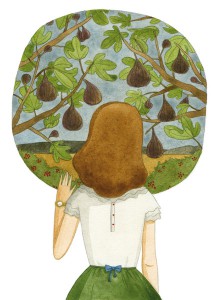
I used this image of a woman looking at a fig tree for my cover because the fig tree was brought up numerous times throughout the book to represent how Esther viewed her own life and the different branches it represents in it. At first it was mentioned in Chapter 5, when Esther connected with the story of the Jewish man and Nun meeting at the fig tree. She relates to her own experience with buddy. “It seemed to me Buddy Willard and I were like that Jewish man and that nun, although of course we weren’t Jewish or Catholic but Unitarian. We had met together under our own imaginary fig tree, and what we had seen wasn’t a bird coming out of an egg but a baby coming out of a woman, and then something awful happened and we went our separate ways.” (Plath, chapter 5) She connects the way the relationship between the Jewish man and the Nun is doomed after they’ve touched hands, the way hers and Buddy’s is doomed. Also, they’re very similar to the Jewish man and Nun due to their differing outlook on life, especially their gender differences.
In chapter 7, Esther mentions the fig tree once more when she is with Constantine and the Russian woman who can recite so many different idioms. She thinks about how inadequate she feels compared to these people and think about the many different ways her own life can branch out. “I saw myself sitting in the crotch of this fig tree, starving to death, just because I couldn’t make up my mind which of the figs I would choose. I wanted each and every one of them, but choosing one meant losing all the rest, and, as I sat there, unable to decide, the figs began to wrinkle and go black, and, one by one, they plopped to the ground at my feet.”(Plath, Chapter 7) She feels that because she is a woman, she has many more responsibilities and options that she can choose. She feels as though she can only choose one way and ends up feeling troubled and indecisive.
This image I chose shows a girl looking out at the tree and the different figs and to me it mainly connects back to Chapter 7 as Esther contemplates her own decisions in life and where she wants to go from there.She has many different possibilities to choose from but this is a great dilemma because she wants to do it all.
The Bell Jar Project 2 Final: A Woman Alone
Final Paper: belljarfinal
Part 2: Project 2 part 2
This is my cover for part 2 of the project. Please check the link for more info on what inspired it, and the program i used to create this image. I would love any feedback from classmates! Thanks everyone.




